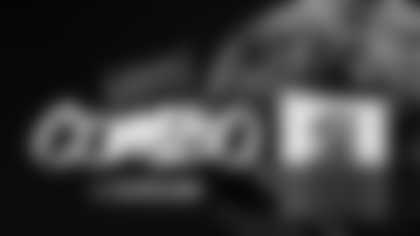When Anthony Munoz found out Thursday that two old teammates were joining him and franchise founder Paul Brown in the Bengals' inaugural Ring of Honor class, the Pro Football Hall of Fame left tackle wasn't exactly caught off balance.
"I tell you what, 13, 14," Munoz said of the uniform numbers of Ken Riley and Ken Anderson. "Oh my goodness. As the years go on, we'll get to see all the great players we had in this organization. But to go in with the innovator, the starter of the franchise and Kenny Anderson and Kenny Riley, such great people and players, it's humbling. It's pretty exciting to be part of this first class."
Elizabeth Blackburn, the club's director of strategy and engagement, said Anderson and Riley were "the clear" winners of the vote by Season Ticket Holders. It's no surprise to those on the ballot.
"No brainer," said Dave Lapham, Munoz's Super Bowl guard and long-time Bengals radio analyst.
No one caught more touchdowns from Anderson (51) than wide receiver Isaac Curtis. And no one probably covered Curtis more than Riley, given that they practiced against each other for 11 years.
"They were my two picks," said Curtis, who along with Lapham and the other 13 former players who were candidates remain on the ballot for the next ROH vote.
Anderson and Riley are not only two of the greatest players in Bengals history, but they are also two of the most modest who excelled at their profession with no-frills blue collars. It's a big reason they were so popular with their teammates and that humility was on display during Thursday's Zoom call with Anderson and the late Riley's son, Ken Riley II.
Anderson, 72, one of only five men to win at least four NFL passing titles, talked about walking into Paul Brown's office the day after Brown plucked him out of tiny Augustana College in the 1971 draft.
"I got to meet Paul Brown behind his desk and just the awe I had to be in his presence," Anderson said. "When you think back to the success that he had in professional football. I think the marks that he made—basically the way that teams operate now, whether it's an offseason standpoint or how practice is organized and how you meet—Paul Brown started that whole thing. Just to be a part of him. Sometimes the only thing I wish is that I would've been around him when he was a bit younger and might've been a little bit more involved in the game planning."
Even though Riley racked up the fifth most interceptions of all-time with 65, he was also known for his tackling. Riley II, sadly but sweetly, recalled how as a kid he would imitate his father's tackling style on his younger sister. His signature hit was simply but effectively taking out the ball carrier's feet and ending up in an unwelcome cart wheel.
"He was just like what all y'all have said about him," Riley said. "He wasn't one to say a whole lot but he demanded respect. When he said something, we listened. He was still not a 'rah, rah, rah' guy but when he said something, OK, I better do it. And always just caring and loving, just like a father. He was a great guy, a great man. I have the utmost respect for him. He was my hero. He was just a great guy, my hero. Good guy.
"He was a very quiet, but he was super competitive. You don't get to that level without being competitive. Even though he was laid back, he definitely had a fire in him. He was so competitive, I always joked he had a golf tournament every year and every year he would take his golf clubs but he never played. He would say it was because he was busy and had to run around and do other things that revolved on the tournament. But the reason why is he hates to lose. He never played, and after I got to a certain age shooting pool and was able to beat him he stopped playing. Just the competitive nature of him and he hated to lose to anybody. That's just who he was."
The selections of Anderson and Riley weren't the only logical moves on Thursday. It turns out it was also Ken Riley III's birthday, the 16th for the Houston high school defensive end.
And since the Fab Four are prominent members of the Bengals' first Super Bowl team celebrating its 40th anniversary, the Thursday night Ring of Honor ceremony at the Sept. 30 game against the Jaguars also coincides with the Paul Brown Stadium crowd saluting a reunion of the 1981 AFC champions.
Not only that, but eight of the 17 Ring candidates played on that team that is generally regarded as the Bengals' best. Since all the candidates are invited to the ceremony, some are there for two reasons in a rollicking celebration of Bengaldom.
"I'm double dipping," Curtis said. "We had a bunch of really good guys on that team and we got along well. We had fun on the field and off the field. We really enjoyed each other. We played hard and we played for each other. It was special. Offensively, we could beat anybody as long as we slowed some people down. I thought we had the best team in the NFL even though we didn't win the Super Bowl. Sometimes the best team doesn't always win."
1981 is Anderson's signature moment of what should be a Hall of Fame career. Benched in the opener, he talked his way into the next week's start and led the Bengals to a 31-30 victory over the Jets at Shea Stadium that jump-started his MVP season.
"Kenny came back," said Curtis, who helped his buddy with a monstrous 108 yards. "Sometimes you hit a rough patch. Just for a minute before you get your feet back on the ground. Just some decisions that weren't right. But there was no question who the No. 1 quarterback on that team was."
That '81 team just may be the classic Paul Brown club. It was coached by innovators on offense with Lindy Infante's new option routes and on defense with Hank Bullough's now-you-see-them-now-you-don't blitzes out of a then funky 3-4. And a second-year offensive line coach named Jim McNally was becoming a guru with intriguing zone blocking. Even Curtis says Anderson was so effcient and smart he could have coached the scheme. And Anderson, of course, coached longer in the league than he played.
"Jimmy came in and we had some new protections," said Lapham, the left guard. "They were definitely cutting edge on defense with Hank, "The Doctor of Defense." And Dick LeBeau was doing his thing in the secondary. That staff had some great coaches. P.B. knew what he was doing."
Munoz points to McNally switching a young tackle named Max Montoya to right guard in time for that season. Montoya emerged as a perennial Pro Bowl player and one of those players who returns to the Ring of Honor ballot.
"That just shows you," Munoz said of McNally's influence.
Munoz recalls how Anderson was "beat up," in the couple of seasons leading up to '81. But Anderson knows what happened.
"When my career was going down, it all shifted when we got Anthony and Max and Blair Bush and Lapham, and Mike Wilson and I got good again," Anderson said. "Is there a correlation there somehow?"
Louis Breeden, who started opposite Riley on the '81 corner, saw it.
"If you can protect Ken Anderson, look what's going to happen," Breeden said. "That was one of the only big differences (that year). When you look at it, the defense was pretty much the same. On offense, (rookie wide receiver) Cris Collinsworth was a big addition. But, I hate to use a cliché, it all just came together. We finally jelled."
If this was a classic Paul Brown team, Breeden was a classic example. He was mentored by Riley, a virtual coach on the field who became the head coach of his alma mater at Florida A&M. The same Riley who would tap Curtis on the helmet just before a play in practice when he saw the rookie's eyes wander to everywhere but where they should have been.
"Head up, Rook," Riley would tell him.
"I had never played the position and he taught me. And I wasn't the only guy he helped. There's a line of them," Breeden said. "To me, the most amazing thing he did was after he had a Hall of Fame career in college at quarterback, without ever playing defense he came into the NFL and had a Hall of Fame career at cornerback. And he did a lot of it on his own until Dick LeBeau came late in his career."
The '81 teammates are already talking about coming in for September. Breeden has heard from wide receiver Steve Kreider. Curtis has heard from Ross Browner. It turns out the first Bengals team that got an AFC ring is going to enjoy the new ring.
"They got the first four right," Breeden said.








